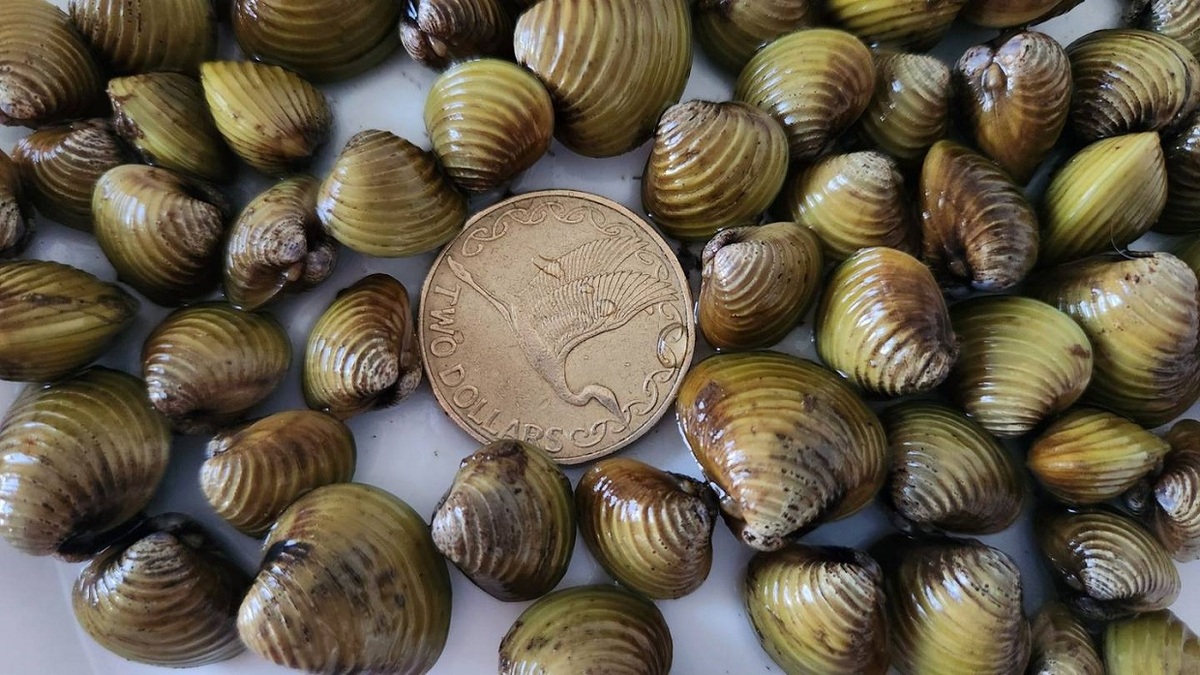People urged to keep eye out for freshwater pest
Staff Reporter
18 July 2023, 1:39 AM
 Freshwater gold clams, with a coin for scale. PHOTO: Supplied/Tracey Burton, Toitū Te Whenua Land Information New Zealand
Freshwater gold clams, with a coin for scale. PHOTO: Supplied/Tracey Burton, Toitū Te Whenua Land Information New ZealandRecreational water users in Otago are being urged by the Otago Regional Council (ORC) to be vigilant after the discovery of a new aquatic pest species in New Zealand.
The freshwater gold clam (Corbicula fluminea) was discovered along a stretch of the Waikato River in May this year, and poses a new threat to New Zealand waterways, native freshwater species and infrastructure.
Since its discovery, Biosecurity New Zealand has been conducting surveillance in the wider Waikato region and a targeted selection of lakes and rivers around the country.
To date, clams have only been found along a 45-kilometre stretch of Waikato River, from the Lake Karāpiro area to Hamilton. Testing for environmental DNA returned positive results on some water samples from Waikato River outside this area, but they are early results that need validating.
It is not yet known how the pest arrived in the country.
In Otago, ORC’s Biosecurity team have concerns the fast-spreading pest could hitch a ride from northern lakes and rivers to Otago lakes and waterways, ORC Environmental Implementation manager Libby Caldwell said.
“Our worry is that people transporting recreational equipment such as boats and trailers, fishing gear, paddleboards, kayaks, or jet skis between the North and South Islands may inadvertently bring this new pest to Otago. That’s why we’re getting the word out now in the hope we can prevent a new aquatic pest from invading our lakes and rivers.”
Freshwater gold clams can spread when they attach to boats or are carried in ballast water, used as bait, through the aquarium trade or carried further afield by water currents.
“It’s best practice to get in the habit of thoroughly washing down any recreational freshwater equipment, away from lakes and rivers. This method also takes care of a variety of other pests, like lagarosiphon and didymo,” Libby said.
If people think they have found freshwater gold clams, Libby asks that they take a photo and report the location to ORC or Biosecurity New Zealand.
The clams reproduce rapidly and form large populations, which can clog water-based infrastructure such as electric generation plants, irrigation systems, and water treatment plants.
They are filter feeders and can compete with native species for food.
Juveniles spread passively in the water column. In rivers, colonisation downstream is easily achieved, as juveniles are transported by currents, or through being attached to floating vegetation.
The freshwater gold clam is native to eastern Asia and is widely established in North and South America and Europe.
It is not yet known how this species will respond to New Zealand conditions, but research indicates it has a thermal tolerance of down to 2deg Celsius, which means most of Otago is potentially occupiable for this species.
Overseas, the clam has been preyed on by some species of fish and crayfish, but remains difficult to control and eradication has never been achieved.
If there is an incursion of this pest species into the Otago freshwater system, there are likely to be significant environmental and economic impacts.
Where to look out for this pest:
- Freshwater gold clams are found in freshwater or brackish water (near river mouths), sitting on top of sandy or muddy surfaces, or buried shallowly within them.
- They can also be found among debris, such as leaves, that may have settled on the riverbed.
If you think you've seen the freshwater gold clam:
- note the location
- take a photo (if possible)
You can then either:
- freephone the Otago Regional Council on 0800 474 082,
- freephone Biosecurity New Zealand on 0800 80 99 66 or
- complete the online reporting form at Biosecurity NZ
Or email the ORC at: [email protected]
If you fish, swim, boat or row, follow the Check, Clean, Dry guidelines to help stop the spread of this clam to other rivers and lakes through New Zealand. Before moving to another location at the river, or to another river or lake:
Check
- Remove anything visible including clams, weed, or mud. Drain all water.
Clean
- Wash down your gear and craft with tap-water onto grass beside the river or lake, or at home – not into a stormwater drain system. This will flush off clams that can be too small to be seen.
- For gear made of absorbent materials (for example clothing, wetsuit), which will stay wet longer, you should do a hot wash (above 45 degrees) or pop it in a freezer until solid.
Dry
- Allow gear to dry to touch, inside and out, and then leave it to dry for at least 5 days before going back in a river or lake.
- Dry areas inside the watercraft where water has pooled, for example with an old towel, and then leave the craft to dry for at least five days. The hull of a watercraft will dry when towed.


